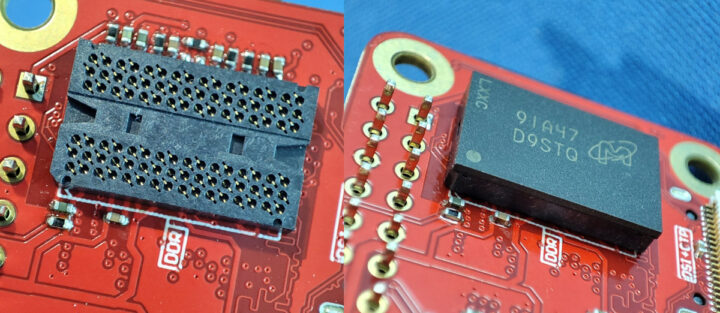In most cases, both the eMMC flash and RAM are soldered on single board computers, but we’ve previously boards with eMMC flash modules that allows to optionally add storage of various capacity and speed. But today I learned something similar exists for RAM chips with a socket that allows you to clip a BGA chip to change RAM capacity.
The BGA socket is simply soldered on the board instead of the RAM chip itself, and as demonstrated on the MangoPi MQ Pro board, you could then insert the chip on the board instead of soldering it.
Those are the specifications of the “DDR3x16-96” socket used above:
- Materials
- Socket base: LCP (liquid crystal polymers)
- Contacts: BeCu (Beryllium Copper), selective Au-Au flash over Ni plating
- Insulation resistance – 1000 MOhm or more at DC 100V
- Dielectric withstanding voltage – 100V AC for one minute
- Contact resistance – 50 mOhm max, at 10mA and 20mV max (initial)
- Operating temperature – -50°C to +150°C
- Life span – 10,000 times (mechanical)
- Operation force – < 2.0 kg max
You’ll find the PCB pattern and those specs on the PDF document released by MangoPi. It appears the socket is designed to go through several insertion/removal cycle with a 10,000 times life span, but it’s unclear how hard is it to remove. But once inserted, it looks firmly in place.
This type of socket has a name, as Tom Fleet explains on Twitter, it is called an “interposer”, and one of the main manufacturers of such sockets is Samtec. The model used in the board is “JRS DDR3x16-96” according to the PDF released by MangoPi, but I was unable to find it anywhere.
While it looks neat, I’m not convinced we’ll see barebone single board computers where users can insert their own eMMC flash and RAM any time soon, since it would likely add to the overall costs. A more likely use would be for board vendors wanting to test RAM chips from various vendors and of different capacities.

Jean-Luc started CNX Software in 2010 as a part-time endeavor, before quitting his job as a software engineering manager, and starting to write daily news, and reviews full time later in 2011.
Support CNX Software! Donate via cryptocurrencies, become a Patron on Patreon, or purchase goods on Amazon or Aliexpress





